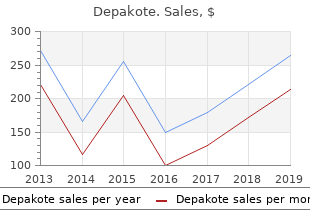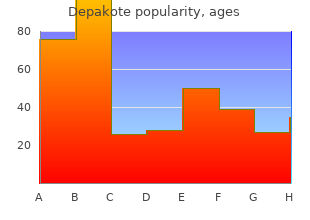Depakote
"Order depakote cheap online, treatment lichen sclerosis".
By: Y. Olivier, MD
Deputy Director, Keck School of Medicine of University of Southern California
Early assessment and management of ChT- symptoms 24 hour flu generic 500 mg depakote overnight delivery, biological therapy and radiotherapy-induced diarrhoea are crucial symptoms 5-6 weeks pregnant buy cheap depakote 250mg on-line, in order to medicine wheel images purchase depakote with paypal prevent severe compliations and preserve the quality of life of these patients. Evaluation and management of treatment-related diarrhea in patients with advanced cancer: a review. Management of chemotherapy-induced nausea, vomiting, oral mucositis, and diarrhoea. Prospective randomized trial of doc etaxel versus best supportive care in patients with non-small-cell lung cancer previously treated with platinum-based chemotherapy. Ballova Narodny onkologicky ustav, Hemato-oncological Department, Bratislava, Slovakia Introduction the gastrointestinal tract is a common site of infection in neutropaenic patients. The clinical manifestation of different types of abdominal infection in neutropaenic patients is not specifc. The physical fndings may be minimal at the time of diagno sis in severely immunocompromised patients, and rapid progression to fulminant septicaemia may precede the development of more typical abdominal signs. A combination of clinical features, radiographic and microbiological fndings, serological and sometimes also histopathologi cal results is needed to make a specifc diagnosis. Abdominal infections in neutropaenic patients are life-threatening situ ations with substantial morbidity and mortality. Management includes bowel rest, correction of cyto paenia and coagulopathies, as well as administration of broad-spectrum antibiotics and antifungal agents. Surgical interventions are necessary in certain types of abdominal infection or to manage complications such as perforation and haemorrhage. Abnormalities in the small bowel were present in 66% of cases (Kirkpatrick & Greenberg 2003). The most frequent causes of death are uncontrolled bleeding, perforation or irreversible sepsis with multi ple organ failure. Early recognition and appropriate medical or surgical management could reduce mortality. The symptoms include severe epigastric discomfort, vomiting and circulatory collapse with neutropaenia resulting from chemotherapy or immunosuppression. Combination of neutropaenia, mucositis and achlor hydria (caused by proton pump inhibitor treatment) may be predisposing factors. Gastric biopsy can reveal gastric necrosis and identify an infltrating microorganism. Patients considered suspect are those presenting with watery diarrhoea (three or more stools within 24 hours), mostly previously treated with antibiotics. It may also occur in patients with aplastic anaemia who have not received cytotoxic therapy. The incidence is increasing mostly because of intensi fed use of broad-spectrum antibiotics. Use of certain cytotoxic drugs was thought to be directly related to the development of this complication (Table 2). Pathophysiology On the basis of the pathophysiological data of gastrointestinal complica tions in neutropaenic patients, it is possible that neutropaenic enterocol itis, pseudomembranous colitis and ischaemic colitis may share a simi lar pathophysiological basis and probably represent varying degrees of bowel infammation and necrosis, elicited by cytotoxic drugs (Table 3). Concurrent factors causing severe mucosal injury in neutropaenic patients can contribute to a rapid life threatening course of this complication. The mechanism of chemotherapy-induced pseudomembranous colitis seems to be explained by development of severe infammatory changes, disruption of the normal colonic epithelium and mucosal necrosis. Clinical Manifestations Clinical symptoms of abdominal infections are not specifc, and include fever and abdominal signs occurring during a period of neutropaenia, classically beginning 7�10 days after chemotherapy (Table 4). Even in the presence of sepsis, physical fndings may be minimal, and rapid Abdominal Infections in Neutropaenic Patients 187 progression to fulminant septicaemia may precede the development of more pronounced abdominal symptoms. Recovery from neutropaenia can be occasionally associated with clinical worsening, due to recovery of the infammatory response. Late complications such as perforation, bleeding or abscess formation may occur after recovery from neutropaenia. Table 4 Manifestations of Abdominal Infections in Neutropaenic Patients Clinical fndings n Fever n Protracted diarrhoea (watery or bloody) n Vague abdominal pain n Progressive abdominal distension n Nausea and vomiting n Intestinal bleeding Physical fndings n Abdominal distension n Tenderness in right lower abdomen (may vary depending on severity, location n Mass in right lower abdomen and presence or absence of complications) n Hypoactive bowel sounds n Tympanic abdomen Warning signs suggesting n Rebound tenderness perforation and peritonitis n Rigidity n �Silent� abdomen n Hypotension n Clinical deterioration despite optimal therapy Diagnosis To establish the exact diagnosis in neutropaenic patients with fever and abdominal symptoms continues to be challenging.

The objective measurement of physical activity is another notable strength of this study symptoms e coli generic depakote 500 mg mastercard. Cardiorespiratory fitness is negatively associated with a clustering of metabolic risk factors in children symptoms 9 days post ovulation order depakote toronto. The results suggest that there is a minimum cardiorespiratory fitness level required in order to treatment 12th rib syndrome discount depakote 250 mg on-line have a low metabolic risk. Physical activity, cardiorespiratory fitness, and body fat are not significantly associated with tHcy levels in children and adolescents. Vigorous intensity physical activity is negatively associated with body fat in children, whereas both total and at least moderate-vigorous physical activity are positively associated with cardiorespiratory fitness. I want to express my sincere gratitude to: Michael Sjostrom, tutor, for giving me the opportunity to work in his group, and in such a good project. Thanks for your tremendous support, constructive criticism, and for believing in me, always. Anita Hurtig-Wennlof, co-tutor, for your wise and generous advices both in professional and personal life. Thanks for giving me the drops of patience that are often lacking in my Spanish temperament. Manuel Castillo and Angel Gutierrez, co-tutors, for sharing your most critical view of my work, and your deep knowledge of physiology. Having your approval makes scientific life much easier Francisco Ortega, Nico Rizzo, Julia Warnberg, Emma Patterson, and Torbjorn Nilsson, all co-authors, for your support, good discussions, and always wise advice. Jan-Ake Gustafsson, for giving the opportunity to become a graduate student at the Department of Bioscience and Nutrition and for your support to the Unit of Preventive Nutrition. Maarike Harro, recently deceased, for giving me the opportunity to use the Estonian data, and for your always positive approach. Thanks also to Toomas Veidebaum for your helpful collaboration, and my co-authors Inga Villa, and Leila Oja. Yes, arrieros we areTo Dirk Meusel and Signe Altmae, life in Stockholm would not have been the same without you, thanks for the Estonian saunas with German humor on Sunday evenings! To Juan Jesus Carrero, for sharing many interesting coffee breaks, and trips and dreams to somewhere. The studies included in this thesis were supported financially by grants from the Stockholm County Council, the Estonian Science Foundation, and the Ministerio de Educacion y Ciencia de Espana. Ekelund U, Aman J, Yngve A, Renman C, Westerterp K, Sjostrom M (2002) Physical activity but not energy expenditure is reduced in obese adolescents: a case-control study. Gallistl S, Sudi K, Mangge H, Erwa W, Borkenstein M (2000) Insulin is an independent correlate of plasma homocysteine levels in obese children and adolescents. Sjostrom M, Poortvliet E, Nelson M (2005) Monitoring public health nutrition in Europe: nutritional indicators and determinants of health status. Additional measured outcomes included adolescents, as has been found in adults (8�10). A metabolic risk score was computed as the seems to be an independent predictor of metabolic syndrome mean of the standardized outcomes scores. Collectively, cross-sectional, longitudinal, and in high metabolic risk in girls and boys (p 0. It has been suggested that clustering of cardiovascu these years (2�5) and also later in life (6). The perfect test that correctly tions between personal, environmental, and lifestyle inuences on the risk classies all subjects has a true-high rate of 1 and false-high rate of 0. Study design, selection criteria, and Therefore, the optimal combination of true-high rate and false-high rate is the sample calculations have been reported elsewhere (13,14). One 1 � specicity pair was calculated, and, then, the pair closest to 1 was chosen. None of the analyzed variables showed a statistically sig IdenticationofpubertaldevelopmentwasassessedaccordingtoTanner(18). Pubertalstagewasassessedbyaresearcherofthesamegenderasthechildby nicant difference between the included subjects and the brief observation. Breast development in girls and genital development in subjects who did not provided a whole set of data. The subject 97% had blood pressure measurements and 98% had blood was in a seated and relaxed position, and recordings were made every second measurements.

Patient reports of increased commitment to symptoms webmd buy depakote 500 mg learning and adopting a pain self-management approach early in treatment mediated adherence and improved outcomes (Burns Therapist Manual 27 et al treatment wpw order on line depakote. Interestingly treatment yeast in urine buy 250 mg depakote with visa, patients� reports of the strength of the therapeutic relationship and expectancies about treatment benefts, conceptualized as general or non-specifc mechanisms of change, were also signifcantly associated with adherence and outcomes. Together, these fndings encourage therapist efforts to build a strong therapeutic alliance and to promote optimism about the benefts of treatment, and to foster a commitment to adopting a pain self-management approach early in treatment. What remains less clear, however, is the degree to which specifc coping strategies, such as pacing, challenging negative thoughts, or relaxation, impact the identifed processes of change. Recent research also reinforces the value of emphasizing the establishment of a strong therapeutic alliance and expectations of beneft early in treatment. From a clinical perspective, the process studies suggest the need to listen for the presence or absence of important indicators of change in the same way that practitioners of Motivational Interviewing listen for �change talk. The therapist uses this information to formulate hypotheses about the Veteran�s presenting problems and what is maintaining them. His primary care physician referred him for assistance with how he can better manage his pain. Reggie was diagnosed with diabetes 9 years ago but the painful tingling and numbness in his feet has worsened over the last 2 years. He is now mostly sedentary and spends most of his day watching television in his recliner. While he was overweight when diagnosed, he is now morbidly obese and has gained 30 pounds this year. His provider shared that Reggie has not taken his pain medications consistently, and has discontinued physical therapy after one session since it created increased pain. Reggie is frustrated and angry about his lack of mobility and need to use a rolling walker when walking long distances. He wants to be able to play with his grandchildren and be more active with his church, but lately he has not even been attending services since it is too diffcult to get going. The Veteran has been coping with pain for much of the last 10 years but, after years of frustration and work-ups, was only diagnosed with fbromyalgia in the last year. Sheila works as a competitive dog trainer and has been cutting back on her number of clients due to diffculty maintaining appointments before noon and the physical nature of the job. The Veteran realizes that if she can�t get her pain and the accompanying symptoms under better control she may lose her job and her relationship. He was referred by his licensed clinical social worker who believes that poorly managed pain is complicating his treatment with her for his depressive symptoms. Juan�s pain complaints began 4 years ago when he fell off of a truck in Afghanistan and ruptured a disc in his lumbar region. The injury necessitated immediate surgery to alleviate pressure on his spinal cord. One year after the initial surgery, he elected to have a second surgery to alleviate ongoing pain but it was not successful. He is trained to work as a computer network manager but for the last 2 years he has been unable to maintain a job for longer than 6 months due to problems with fatigue and pain. Juan spends time with some �buddies� from high school but never mentions his back pain or depression, and frequently fails to show at gatherings or answer text messages from friends. Finally, Juan�s physician has expressed concern about his increasing weight, which is now in the range of mild obesity. It is always important to consider the need for additional follow-up questions as well as treatment implications. Biological � Bilateral neuropathic foot pain secondary to diabetes; joint pain in knees and ankles � Consider impact on mobility � Obesity and recent weight gain � Diet considerations in addition to exercise � Inconsistent use of medications � Education re: need for proper trial Psychological � Frustrated and angry with limitations � Assess for other emotional symptoms and previous use of mental health services Social � Supportive wife � Evaluate possible solicitous behaviors � Social isolation and inactivity � Spirtual considerations 30 Therapist Considerations Chronic pain can be an incredibly stressful condition eliciting vulnerabilities in patients that may not otherwise be expressed. For this reason, Veterans may present with a complex array of issues and comorbidities than can complicate assessment and treatment. This section is designed to help the therapist gain a better understanding for the Veterans� experiences as well as feel more confdent in addressing challenging situations. Several key topics that may be particularly diffcult for providers to address will be reviewed. Anticipating these issues and being prepared will help foster a collaborative relationship with the Veteran.
Purchase depakote 500mg online. HIV My Experience.


